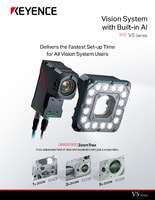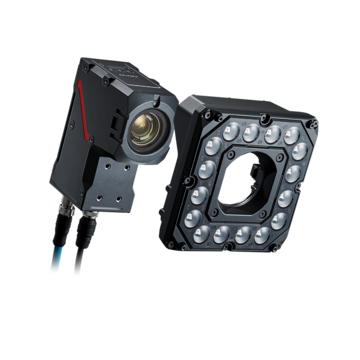Vision Systems
- Vision System with Built-in AI VS series
- Intuitive Vision System CV-X series
- Customizable Vision System XG-X series
- GigE camera and lighting for PC-based machine vision VJ series
- Inline 3D Inspection 3D Vision series
- 3D Vision-Guided Robotics 3D VGR series
- Line Scan Technology Line Scan series
- 2D Vision-Guided Robotics 2D VGR series
- LED Lighting CA-D series
- Lenses (for Machine Vision) CA-L series
- Machine Vision System Database VisionDatabase series
Vision Sensor vs. Vision System
Modern, high-speed mass manufacturing methods simply demand high-quality control standards that are equally as fast and highly reliable. Manual inspection, while being a crucial part of the whole industrial era, has proved to be not just slow but also prone to error and often impeded by several different factors, such as product size, lighting conditions, and fast production lines.
Automated quality inspection, on the other hand, proved to be quite the opposite, as it maximized throughput, enhanced quality, and lowered manufacturing costs, which led many manufacturers towards adopting vision sensors and automated vision inspection systems.
Both vision sensors and automated vision inspection systems excel at repetitive inspection tasks, and they're much faster, more objective, and less prone to error. To the relief of all business owners, they work round the clock. At the same time, they also provide consistent and reliable inspection results at faster rates and larger production scales.
So, there's no good reason to avoid implementing vision sensors and vision systems into a production line. However, for the uninitiated, it's worth mentioning that vision sensors and vision systems aren't the same, and in this article, we'll discuss the differences. Without further ado, let's dive right in.
Differences Between Vision Sensors and Vision Systems
The main difference between vision sensors and automated vision inspection systems lies in their configuration and applications.
Vision sensors are usually charged with simple inspection tasks, such as answering simple yes-no questions on a production line. They capture light waves using photo-sensitive elements and rely on digital signal processors to translate said waves into pixels that generate digital images. Image analysis software then analyzes the pixel pattern to derive critical information about the observed object.
Their simplicity often ties them to production lines, where they perform simpler roles. This includes presence or absence detection, which answers a simple question: Does the sensor see an object in its field of view? If the answer is positive, the sensor will signal the processing unit to move the part to the correct place in the production process and bring another part in its place for inspection.
The inspection process might also look beyond mere presence detection; if the part is damaged or flawed, the sensor will most likely route that part out of the production line for subsequent inspection by a machine operator or staff in charge of manual inspection—which, in some cases, is still necessary.
Sensors are also capable of basic optical character recognition, which enables a vision sensor to read human readable text.
Automated vision inspection systems are far more complex. They usually consist of higher resolution camera units and powerful software. As such, automated vision inspection systems are perfectly capable of replicating sensor operations.
However, their complexity allows them to perform additional functions crucial to the manufacturing process. This includes detecting whether parts and components are adequately guided and precisely positioned where they're supposed to be.
Additionally, automated vision inspection systems are great at discerning and reading codes on packages and individual components that might contain vital information to sort goods and differentiate between different parts within a single production process.
These systems are also great for high-precision measurements and gauging of manufactured or machined parts, as well as creating 3D representations of parts and components through machine learning and sophisticated algorithms.
Choosing the Right Automated Vision Inspection System
Ultimately, when it comes to choosing vision sensors and automated vision inspection systems for a particular application, each business has to determine which of the two is the best fit for its particular applications.
Vision sensors are generally much easier to install and integrate into the production process, which also leads to a more straightforward setup, production-level calibration, and general maintenance. But they're great for simpler operations, like presence detection and go/no-go decisions related to the manufacturing process.
Automated vision inspection systems are more complex and demand more in-depth considerations, as they often cost more and require more time to set up than a standard vision sensor.
Furthermore, their data processing goes beyond simple presence checks—in fact, automated vision inspection systems often combine advanced software solutions with various sensors to provide businesses with a rather broad spectrum of automation applications.
They're also highly customizable and capable of detecting and monitoring several different physical phenomena. They have the option to integrate with other, previously present systems and integrate complex algorithms and AI technology for better decision-making.
Ultimately, the choice between a vision sensor vs vision system comes down to the specific application tied to a specific process in your manufacturing line. While there are sensors in charge of measuring different metrics, vision sensors are ultimately components that are, in most cases, the building blocks of automated vision inspection systems.
Advantages of KEYENCE's Vision Inspection Solutions
If you're looking for a great automated vision inspection system, KEYENCE has got you covered. Our VS Series Vision System is a global standard model with the latest algorithms packed into a user-friendly design that offers solutions to nearly all your inspection needs.
It comes equipped with a complete family of area cameras suitable for different line speeds, installation locations, and various inspection requirements. This includes a multi-spectrum image capture using eight wavelengths of colored light along with a smart light that allows for height extraction on targets that have low contrast.
All models share a common feature, which is an accessible and easy-to-use interface, which subsequently eliminates the need for using multiple devices with different functions for each metric category.
If you're looking for a versatile automated vision inspection system to enhance the effectiveness of your production and manufacturing line, you've come to the right place.
If you want to learn more about the VS Series, please don't hesitate to contact KEYENCE.


